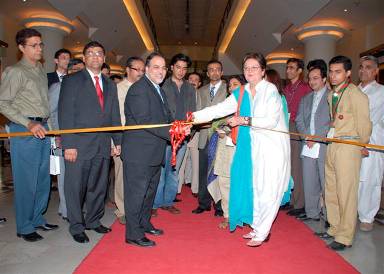 A pencil sketch by one of the participants in the Friends of the Environment art competition. Courtesy of ITREB Pakistan
A pencil sketch by one of the participants in the Friends of the Environment art competition. Courtesy of ITREB PakistanIn Islam, protection of the physical environment is one of humankind's responsibilities as stewards of the Earth. As part of its “Ethic of Sustainable Environment,” the Aga Khan Development Network's Ethical Framework notes that “care of the environment, in its comprehensive meaning, is a duty of trusteeship which humankind owes by virtue of its vicegerency over creation.”
As issues of climate change, pollution and energy consumption dominate world headlines, members of the Jamat, together with other citizens of the world, are increasingly aware of their own impact and responsibility over the environment. While younger generations in particular may witness the full force of these issues, they are also able to contribute towards solutions.
Supported by the Ismaili Council for Pakistan, the contest was organised in three age groups comprising 9 to 20-year olds and drew some 40 000 participants at more than 1 000 screening locations. Artwork themes covered a variety of topics including contaminated water, noise pollution and the impact of earthquakes in Pakistan.In December 2007, the Aga Khan Planning and Building Service, Pakistan launched an art competition with the objective of encouraging youth to participate in a fun activity, while simultaneously raising awareness about the importance of the natural environment and methods of preserving it. The Friends of the Environment competition brought together young participants from cities and villages across the country to explore these issues through drawing and painting.
 Chief guest, Mr Iqbal Walji, President of the Ismaili Council for Pakistan, and the guest of honour, Ms Salima Hashmi, inaugurate the exhibition at the national finals in Lahore. Courtesy of ITREB Pakistan
Chief guest, Mr Iqbal Walji, President of the Ismaili Council for Pakistan, and the guest of honour, Ms Salima Hashmi, inaugurate the exhibition at the national finals in Lahore. Courtesy of ITREB PakistanBased on the quality of their work, around 4 000 participants were selected to take part in local competitions where they were given an art kit and had 90 minutes to produce a new piece. A jury evaluated their work on criteria that included originality, skill, ability to inspire, and thematic relevance.
Three-hundred twelve local winners advanced to regional competitions held at ten locations across Pakistan, where they were asked to create works of art representing one of eight themes. A jury of artists of national repute then selected 30 winners. These larger events were also marked by presentations and small exhibitions on the environment, as well as the distribution of certificates.
 A regional winner from Islamabad who lost his forelimbs, sketches with his feet during the final event. Courtesy of ITREB Pakistan
A regional winner from Islamabad who lost his forelimbs, sketches with his feet during the final event. Courtesy of ITREB PakistanThe Friends of the Environment competition culminated at Lahore in June 2008 with an impressive final ceremony that celebrated all the contributions and recognised the top 30. Winning pieces were placed on display for the public and artists from the oldest age category inspired attendees by performing live paintings.
Addressing an audience of 700, Chairman Hafiz Sherali of the Aga Khan Planning and Building Service, Pakistan said “the paintings that are on display not only reflect the artistic abilities of our youth but also light a candle of hope, that we may live in a healthy environment.” The audience was also treated to a stunning musical performance by Shehzad Roy, President of Zindagi Trust, while major national media networks provided coverage of the festivities.
 Mrs Uzma Al-Karim, master of ceremonies at the final event, receives a shield from the chief guest. Courtesy of ITREB Pakistan
Mrs Uzma Al-Karim, master of ceremonies at the final event, receives a shield from the chief guest. Courtesy of ITREB PakistanFriends of the Environment shed light on a number of talented artists and engaged many youth in issues affecting the environment. Some may seek to contribute to environmental initiatives, including projects already underway in Pakistan, such as the rehabilitation of the Altit and Baltit forts in the Northern Areas or the promotion of indoor air purification technologies for populations in rural areas.
With a generation of artists and youth better informed about the challenges of the environment, Pakistan may look to the future with greater hope.








